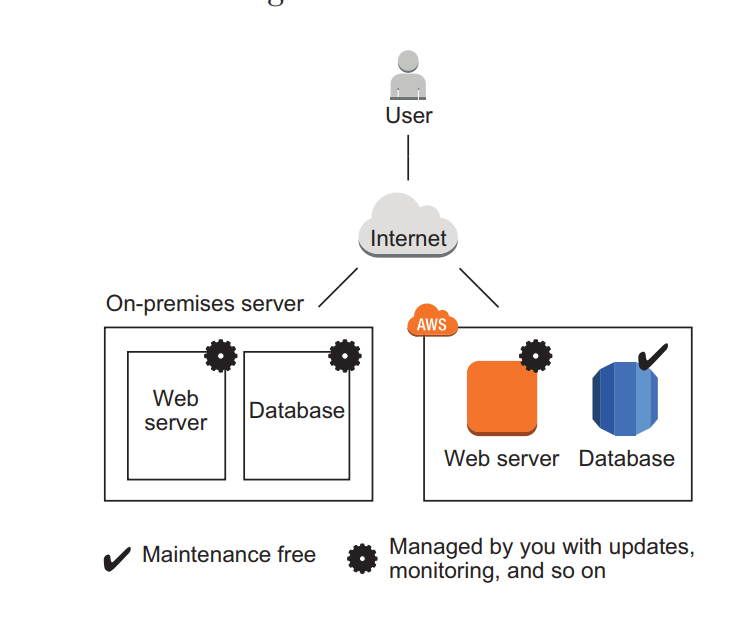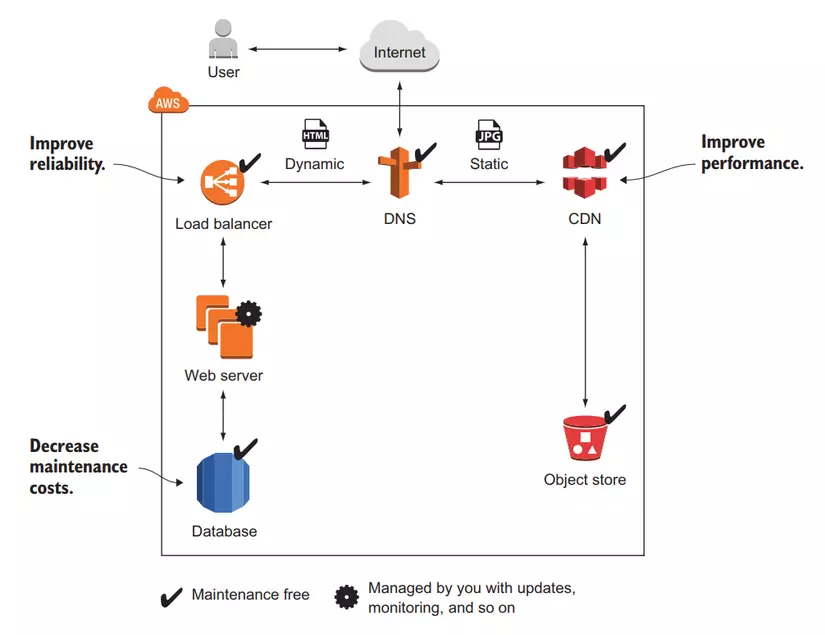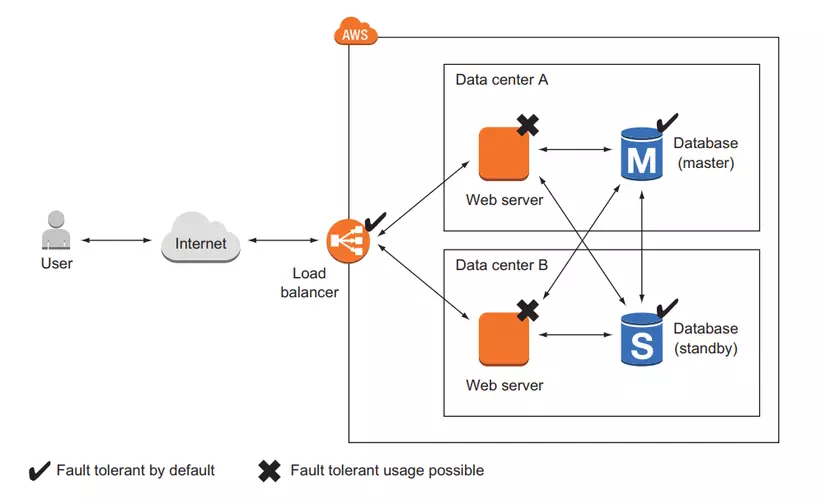Related article: Application of AWS in practice
You can run all kinds of applications on AWS by using one or more services. In this section we will provide examples of what you can do with AWS.
Hosting a shop website
Teo is the CIO for the mid-sized commercial enterprise. He wants to develop fast and reliable web shop. He originally set up a web shop server in the on-premises format (the enterprise’s own server), and three years ago he rented the device in the datacenter. The server processes requests from customers and the database stores product and order information. Teo is evaluating how to take advantage of AWS to run the same setup on AWS.

| On-premises server | AWS |
|---|---|
| Web server: managed by you | Web server: managed by you |
| Database: managed by you | Database: Managed for free by AWS |
Not only does Tèo want to upgrade and migrate his infrastructure to AWS, but he also wants to take advantage of the advantages AWS offers. The services AWS provides to improve his installation:
- Web shop includes: dynamic content (such as products and their prices) and static content (company logo). Breaking up these pieces helps to reduce load on the web server and improve performance by serving static content over the content delivery network CDN (content delivery network).
- Switching to a maintenance-free service: database, object storage, DNS system. Help Teo not to manage these parts on the system, reduce operating costs and improve quality.
- Applications running on web shop can be installed on virtual machines. Using AWS, Teo can run the same amount of resources as using on an on-premise machine. But the advantage of AWS over on-premise is that he can split into many smaller virtual machines at no extra cost. If one virtual machine fails, the load balancer sends the client request to another virtual machine. This setting helps to improve the web shop’s reliability.

Running web shop on AWS with CDN helps to improve access speed. The load balancer improves reliability, and the database is managed for free, helping to reduce maintenance costs.
Teo feels happy running a web shop on AWS. By moving his infrastructure to the cloud improves web shop’s reliability and access speed.
Run Java EE application in private network
Ti is a senior system architect in a global corporation. He wants to migrate parts of his company to AWS when the data center contract expires in the next few months, to minimize costs and gain flexibility.
He wants to run enterprise applications (such as a Java EE application) that includes an application server and an SQL database on AWS.
To do that, Ti needs a virtual network in the cloud and connects to the corporate network through a Virtual Private Network (VPN). He installs the required server application on the virtual machine to run Java EE. I also want to store data on SQL database services (Oracle database, Microsoft SQL Server, ..).
For security, Ti uses subnets to separate systems with different security levels. By using the access-control list, Ti can control the incoming and outgoing traffic for each subnet.
Example: The database can only be accessed from the JEE server subnet to help secure important data.
You can control Internet traffic by using Network Address Translation (NAT) and firewall rules.

A manager to connect the local datacenter to a remote private network on AWS to allow client access to the JEE server.
To start, Ti uses a VPN to create a local datacenter connection with AWS, but he has been thinking about setting up a dedicated network connection to reduce network costs and increase network throughput in the future.
The project was a great success for Ti. He can reduce enterprise application setup time from months to hours, as AWS solves the problem for you with virtual machines, databases, and even on-demand network infrastructure. within minutes.
Ti’s project also benefits from the low cost of AWS infrastructure, compared to using the on-premises infrastructure.
High availability system deployment
The trick is a software engineer working for a fast growing startup. He knows that Murphy’s law applies to IT infrastructure: anything that can go wrong will go wrong.
He is working hard to build highly available systems to prevent business breakdowns.
All services on AWS are highly available or can be used in a highly available manner. So he decided to build a system with a high availability architecture:
- Database services provide replication and redundancy processing. In case the master database fails, the standby provides a new master database automatically.
- Tips for using virtual machines as web servers. By default, these virtual machines are not highly available, but Tip can initialize multiple different datacenter virtual machines to achieve high availability.
- The load balancer service checks the web server’s stability and sends requests from users to how the machine works properly.

So far, Tip has protected the startup from major incidents. However, he and the team are always planning for failure and constantly improving the system’s resilience.
Benefit from low cost for your batch process infrastructure
Ox is a data scientist and he needs to process vast amounts of measurement data collected from gas turbines. He needs to generate maintenance reports for hundreds of turbines per day. So his team needs a compute infrastructure to analyze new data every day.
Batch jobs are run as scheduled and store the aggregated results in a database. Business intelligence tool (business intelligence tool) is used to generate reports of data stored in a database.
Since budgets for computer infrastructure are so small, Ox and his team were looking for a cost-effective solution for the data analysis. He figured out how to use the AWS pricing model intelligently:
- AWS charges virtual machines to run per minute. So Ox initializes the virtual machine when it starts batch job, and shuts down the virtual machine as soon as the job is finished. Doing so allows him to pay for infrastructure only when actually using them. This is a big change compared to traditional data centers where Ox has to pay a monthly fee per machine, no matter how little or how much.
- AWS offers redundant servers in their data centers at a substantial discount: If Ox does not matter uptime during the day. He can wait until AWS has an empty server, then Ox’s system will be launched and AWS will discount him by 50%.

Ox is delighted to have the right to spend on primary computing infrastructure that allows him to analyze data at low cost.
You now have a general understanding of what you can do with AWS. In general, you can rent out any application server on AWS. The next section explains 9 advantages that AWS offers you.
… To be continued …
Thank you for your interest. If you find it interesting, please leave an email below, I will email you when the next section is complete.
Reference source: Amazon Web Services in Action, 2nd Edition (Michael Wittig and Andreas Wittig).
